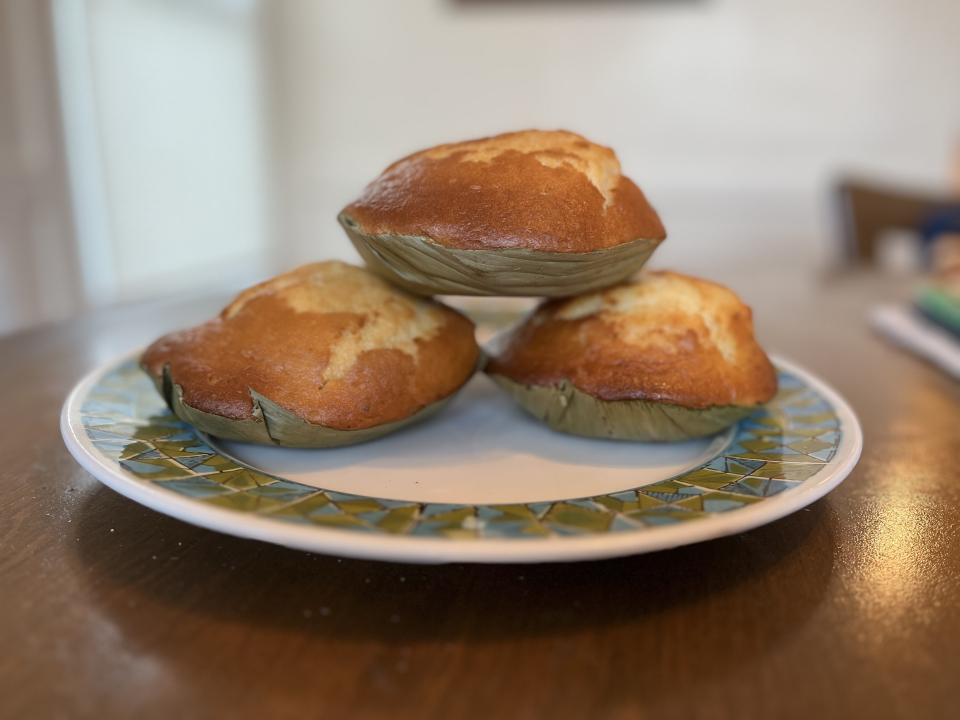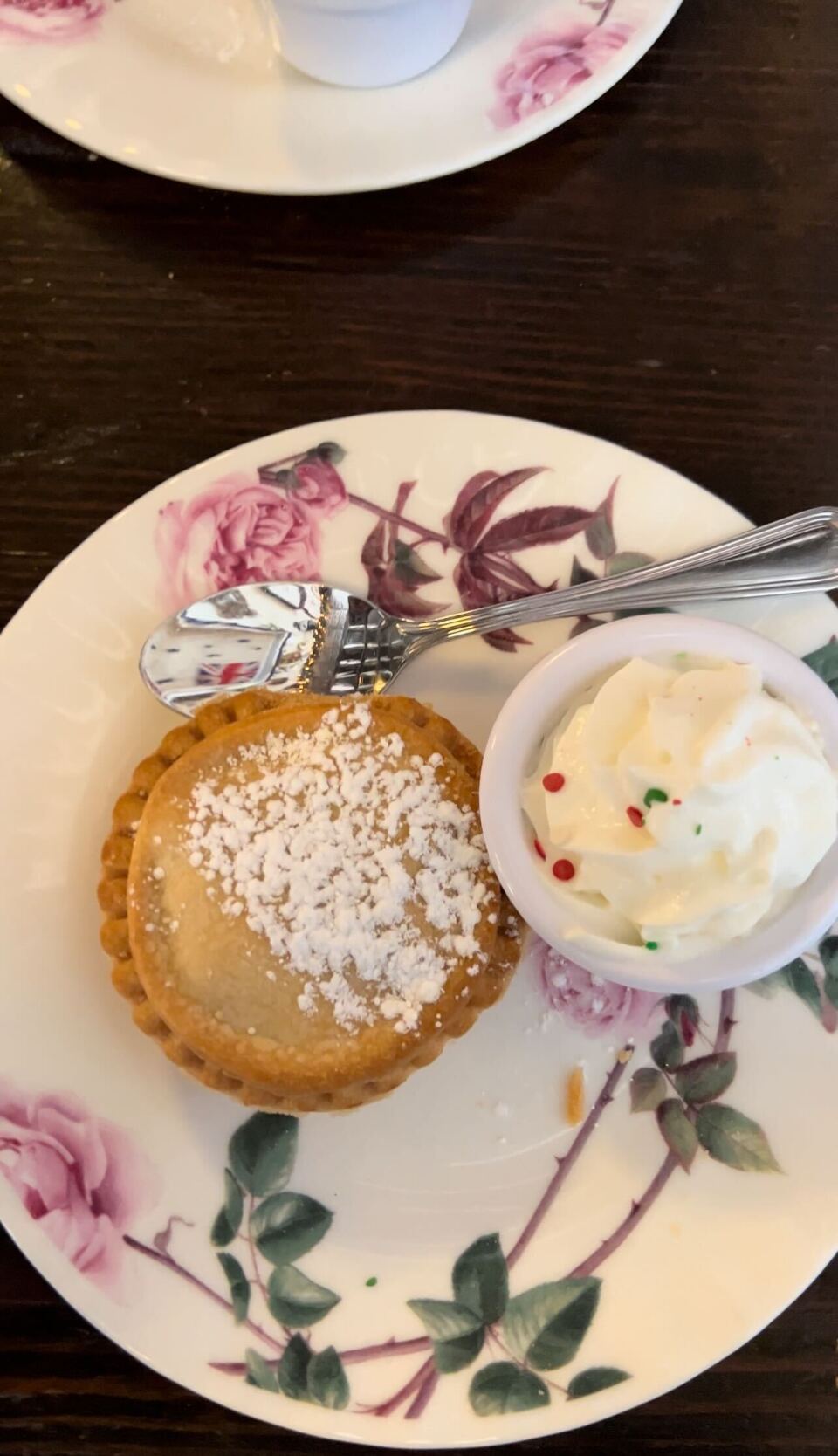This story is free to read because readers choose to support LAist. If you find value in independent local reporting, make a donation to power our newsroom today.
We Share Our Tasty Holiday Traditions From Around The World

The LAist staff come from many backgrounds, as do many Angelenos. When we asked our colleagues what particular food they prepare (or buy) to celebrate the holiday season, the dish that makes them moisty-eyed when they think about it, they responded with dishes from the Philippines to Britain to Guatemala.
So we put it all together, below. We hope it will inspire you to reflect on your own gastronomic holiday traditions when you're gathering with friends and family to celebrate this year.
Panettone Estilo Chileno
Monica Bushman, LAist Studios producer

Monica’s family celebrates the holidays with a panettone, a fruitcake first produced in Italy. It's become a staple because her mother, Maritza, is from Chile, and it reminds her mom of panettone’s Chilean Christmastime cousin, Pan de Pascua.
(I was surprised to learn Pan de Pascua does not just mean Easter; Monica tells me that in Chile it also refers to Christmas. Santa Claus, for example, is called El Viejo Pascuero.)

Monica says it’s “kind of a fluffy round loaf, like an egg bread or a brioche — but it traditionally has candied orange peels, and there are ones with chocolate or pistachio.”
For Monica’s mom, those traditional fruit ones “smell most like what she remembers growing up.”
In Orange County, Monica has bought panettone from the Cortina’s Italian market in Anaheim, but her mom’s favorite place to find them is at the Costco in Fullerton. They buy the Madi brand, an Italian bakery that uses a 50-year-old sourdough starter in the 70-hour process of making the holiday confection.

Monica’s family eats panettone around the Christmas season especially during tea time, where it pairs well with a traditional drink Cola de Mono, monkey’s tail. Which, she says is “a kind of an eggnog or White Russian with milk, coffee, cinnamon, cloves and aguardiente.”
This year Monica splurged on her mom, ordering a panettone From Roy, a Northern California baker who studied under Pierre Hermé, Ferran Adria, and Thomas Keller. And most importantly for Monica’s mom — it’s Oprah’s favorite panettone.
Dutch Baby
Gab Chabrán, LAist Associate Editor, food and culture
Gab tells me that a Dutch Baby is “a big pancake you make in the oven; they have a great look, perfect for Instagram." This buzzy fluffy pastry has become a part of the Chabráns' holiday celebration in recent years.

The Dutch in the name is probably less Holland and more a derivation of Deutsch, meaning German, not too dissimilar from a Pfannkuchen. The Dutch Baby name was trademarked in 1942 by Manca’s Cafe, a popular Seattle restaurant.
But for the Chabráns it has more of a SoCal connection. The Original Pancake House breakfast chain, an Oregon original, still has a few branches here from Whittier to Orange to Encinitas.
Their signature Dutch Baby dish takes twenty minutes to cook so
Gab says it’s the first decision you need to make when you sit down to order.
Katie, Gab’s wife, thought it’d be better if they just started making it themselves, and it has turned into an annual tradition for their family. Each year they alternate between sweet and savory dutch babies. This year it’s sweet, using powdered sugar with some lemon, to make sure it sticks. Another advantage of making it at home — since there's always a few blueberries around, there’s no surcharge to add berries.

Tamales Guatemaltecos
Jill Replogle, Senior Reporter, Orange County

Jill has Arizona roots but spent more than eight years in Guatemala, where she met her husband, Erwin, who's originally from the high altitude pine tree cloudforests of Cobán.
Back in the U.S., their family enjoys Guatemalan tamales during the holidays. She and her husband made "close to 75 tamales from right after the World Cup finale until 10 p.m."
When she can't find hoja de maxán, a large Central American Calathea leaf, she uses banana leaves to wrap her tamales. In Guatemala, maiz masa-based tamales are the most common, but Jill and Erwin usually make paches — which have a mashed potato base, as well as a rice-based masa typical of eastern Guatemala.
For the paches, Erwin makes a sauce with toasted sesame seeds, pumpkin seeds, chiles, and tomatoes, which is then scooped onto either chicken, pork, or a vegetarian friendly mushroom/kale melange.

For tamales de arroz guatemaltecos, you make rice on the stove and keep adding water, butter and oil — it turns to a rice porridge — which is then blended into a sticky base where meat and vegetables can be added. The meat and veggies are raw, so they are cooked by the steamer.
Tamales are a year-round food in Guatemala, but during the holidays they often have extra ingredients. Jill's family adds olives, some peanuts, bell peppers, and capers to make them more festive. These festive tamales are typically eaten on the 24th of December, before presents are opened at midnight, and again on New Year's Eve.
And those 75 tamales that are now cooling her fridge will be eaten at home and given away to friends and family, because during this time of year they're best to eat, says Jill, "just whenever you can. We literally eat them for breakfast, lunch and dinner."
Bibingka
Kristine Malicse, Social Media Producer

Bibingka is the holiday dessert that most feels like home for Kristine, a sweet soft and spongy rice cake baked in a terracotta bowl wrapped with a banana leaf. Christmas in the Philippines is huge.
While Americans might start getting decorations up after Thanksgiving, Kristine says "people start getting their decorations out in September and have them up through December. They call these the 'Brrrr' months."

Bibingka is traditionally eaten throughout the holiday season, but especially after night church services. When she was a kid in Quezon City Kristine would eat the cake around midnight on Christmas Eve, but since she moved to L.A., her family eats it as part of the Christmas meal around 4ish on the 25th. Some people save it for the end of the meal, but Kristine says "I have a sweet tooth so I definitely eat some before the meal."
This year she'll be spending the holidays with her boyfriend and his family. They aren't Filipino so she was thinking about searching the San Gabriel Valley for a great bibingka to share with them as they've never tried it — and maybe create a new tradition along the way.
Deviled Eggs (classic '50s style)
Erin Mercer, Director of HR
Erin knows that there are fancier deviled eggs out there. She’s had the ones with savory truffle-y notes and wasabi accents. She loves them too — but for her family’s longstanding holiday meal, it has to be a traditional deviled egg.

By that, she means yolks pulled from egg whites, seasoned with mayonnaise, a dash of yellow mustard, some salt, paprika and a dollop of sweet relish, then piped back into the egg white and topped with a little more paprika.
Her family has been in Los Angeles for at least three generations. She says she's lucky to still have some relatives in their 90s, who filled up on these protein-dense delicacies during the Great Depression.
The signature 1950s suburban party dish even has its own platter in Erin’s family, which she remembers as a child. Since deviled eggs can be a meal unto themselves, they’re often the first thing served during the holidays. She calls them a “pre-appetizer, when you get the party started early” for a happy hour-style snack time which Erin’s family calls “Happy Talk.”

When it comes to hard-boiling the eggs, Erin has some useful tips (I've been trying Martha Stewart’s 12-minutes-then-ice-bath-method but have been having mixed results.)
“I have learned the best way is in the pressure cooker to hard boil eggs for four or five minutes," she says. Then “let the steam go and the peels will fall right off. As they cool you can cut them in half and they remain intact.”
British Mince Pie
Suzanne Levy, LAist Senior Editor

Suzanne immediately tells me that she’s British (as if I didn’t already know from the accent), which explains why her holiday food choice is mince pies, a popular sweet hand pie served throughout the Commonwealth.
She tells me “it’s a dish first written about in the 14th century, as a way to preserve meat by adding raisins and cloves and cinnamon and other spices in a pie. (In British English “minced” meat means what we would call ground meat.)
These days the the dish doesn’t contain chopped meat — “the meat got less and less, and the sugar got more and more, which is a very British thing.” Even though there is not chunks of meat, traditionally it is made with suet, an animal fat, although this can substituted with other fats or a specially-made vegetable suet if needed.

When it comes out properly, it should, according to Suzanne, be “basically pastry on the outside — no soggy bottom — crumbly shortbread pastry, filling on the inside, a light dusting of icing sugar, what Americans call confectioners sugar, and you should have cream added on top.”
It’s generally eaten at tea-time, with a cup of tea, in the afternoon. Over the holidays, they're everywhere in the UK, but will disappear in January.
"They're like the Pumpkin Spice Latte of Britain," she says. "They’re only available for a limited time.”







